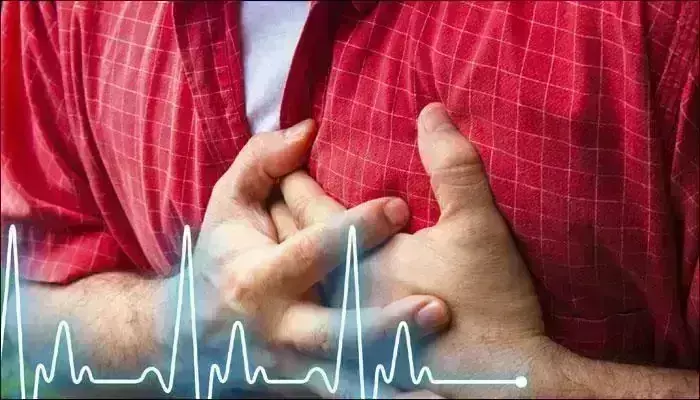- Home
- Medical news & Guidelines
- Anesthesiology
- Cardiology and CTVS
- Critical Care
- Dentistry
- Dermatology
- Diabetes and Endocrinology
- ENT
- Gastroenterology
- Medicine
- Nephrology
- Neurology
- Obstretics-Gynaecology
- Oncology
- Ophthalmology
- Orthopaedics
- Pediatrics-Neonatology
- Psychiatry
- Pulmonology
- Radiology
- Surgery
- Urology
- Laboratory Medicine
- Diet
- Nursing
- Paramedical
- Physiotherapy
- Health news
- Fact Check
- Bone Health Fact Check
- Brain Health Fact Check
- Cancer Related Fact Check
- Child Care Fact Check
- Dental and oral health fact check
- Diabetes and metabolic health fact check
- Diet and Nutrition Fact Check
- Eye and ENT Care Fact Check
- Fitness fact check
- Gut health fact check
- Heart health fact check
- Kidney health fact check
- Medical education fact check
- Men's health fact check
- Respiratory fact check
- Skin and hair care fact check
- Vaccine and Immunization fact check
- Women's health fact check
- AYUSH
- State News
- Andaman and Nicobar Islands
- Andhra Pradesh
- Arunachal Pradesh
- Assam
- Bihar
- Chandigarh
- Chattisgarh
- Dadra and Nagar Haveli
- Daman and Diu
- Delhi
- Goa
- Gujarat
- Haryana
- Himachal Pradesh
- Jammu & Kashmir
- Jharkhand
- Karnataka
- Kerala
- Ladakh
- Lakshadweep
- Madhya Pradesh
- Maharashtra
- Manipur
- Meghalaya
- Mizoram
- Nagaland
- Odisha
- Puducherry
- Punjab
- Rajasthan
- Sikkim
- Tamil Nadu
- Telangana
- Tripura
- Uttar Pradesh
- Uttrakhand
- West Bengal
- Medical Education
- Industry
Five other clinical parameters along with LVEF can predict Cardiac Arrest

A recent study published in the Journal of the American College of Cardiology suggests that the prevalence of out-of-hospital cardiac arrest (OHCA) 90 days after Myocardial Infarction (MI) was less than 0.3%. They also found a total of 5 clinical parameters in addition to Left ventricular ejection fraction (LVEF) that can predict out-of-hospital cardiac arrest (OHCA) and non-OHCA death.
The risk of sudden cardiac death (SCD) is high early after myocardial infarction (MI). During the last decades, medical treatment has evolved, rates of in-hospital revascularization have increased, and the outcome has improved following MI. Yet, current knowledge and guidelines regarding SCD early after MI largely rely on trials and registry studies conducted in the 1990s and early 2000s. For this purpose, researchers of Sweden conducted a retrospective study to assess the incidence of out-of-hospital cardiac arrest (OHCA) within 90 days after MI in a contemporary setting restricted to patients without a prior ICD who had undergone in-hospital coronary angiography. They also assessed the patient characteristics beyond LVEF as possible predictors of OHCA.
Researchers used data from SWEDEHEART (Swedish Web-System for Enhancement and Development of Evidence-Based care in Heart Disease Evaluated According to Recommended Therapies) and additional data from the Swedish Cardiopulmonary Resuscitation Registry, and the Swedish Pacemaker and Implantable Cardioverter-Defibrillator (ICD) Registry. A total of 121,379 cases of MI, who had undergone coronary angiography and were discharged alive between 2009 to 2017 without a prior ICD, were followed up to 90 days. Researchers used Cox regression models to assess the associations between clinical parameters and out-of-hospital cardiac arrest (OHCA).
Key findings of the study were:
♦ The median time to OHCA was 11 days (25th and 75th percentiles, 3 and 44 days) after discharge.
♦ Among 121,379 cases, OHCA occurred in 349 (0.29%) and non-OHCA death in 2,194 (1.8%) cases.
♦ During the follow-up period, they observed 301 (86.3%) patients in the OHCA group died.
♦ They also observed a cumulative incidence of OHCA at 30 and 40 days after discharge was 0.19% and 0.21%.
♦ Among OHCA patients, they recorded an initial shockable rhythm in 36.4% of cases.
♦ Researchers identified male sex, diabetes, estimated glomerular filtration rate less than 30 mL/min/1.73 m2, Killip class II or greater, new-onset atrial fibrillation/flutter and impaired left ventricular ejection fraction as independent predictors of out-of-hospital cardiac arrest.
♦ These assigned points, and were grouped into 3 categories, where the incidence of OHCA ranged from 0.12% to 2.0% and non-OHCA death from 0.76% to 11.7%.
♦ When Stratified by LVEF <40% alone they found the incidence of OHCA was 0.20% and 0.76% and for non-OHCA death 1.1% and 4.9%.
The authors concluded, "In this nationwide study, the incidence of OHCA within 90 days after MI was <0.3%. We have shown that the incidence of OHCA is low in a contemporary cohort of post-MI cases. In total, 6 clinical variables including LVEF more accurately predicted OHCA as well as non-OHCA death than an LVEF cut-off of 40% alone".
For further information:
https://www.jacc.org/doi/10.1016/j.jacc.2020.10.033#d14635245e162
Medical Dialogues Bureau consists of a team of passionate medical/scientific writers, led by doctors and healthcare researchers. Our team efforts to bring you updated and timely news about the important happenings of the medical and healthcare sector. Our editorial team can be reached at editorial@medicaldialogues.in.
Dr Kamal Kant Kohli-MBBS, DTCD- a chest specialist with more than 30 years of practice and a flair for writing clinical articles, Dr Kamal Kant Kohli joined Medical Dialogues as a Chief Editor of Medical News. Besides writing articles, as an editor, he proofreads and verifies all the medical content published on Medical Dialogues including those coming from journals, studies,medical conferences,guidelines etc. Email: drkohli@medicaldialogues.in. Contact no. 011-43720751


